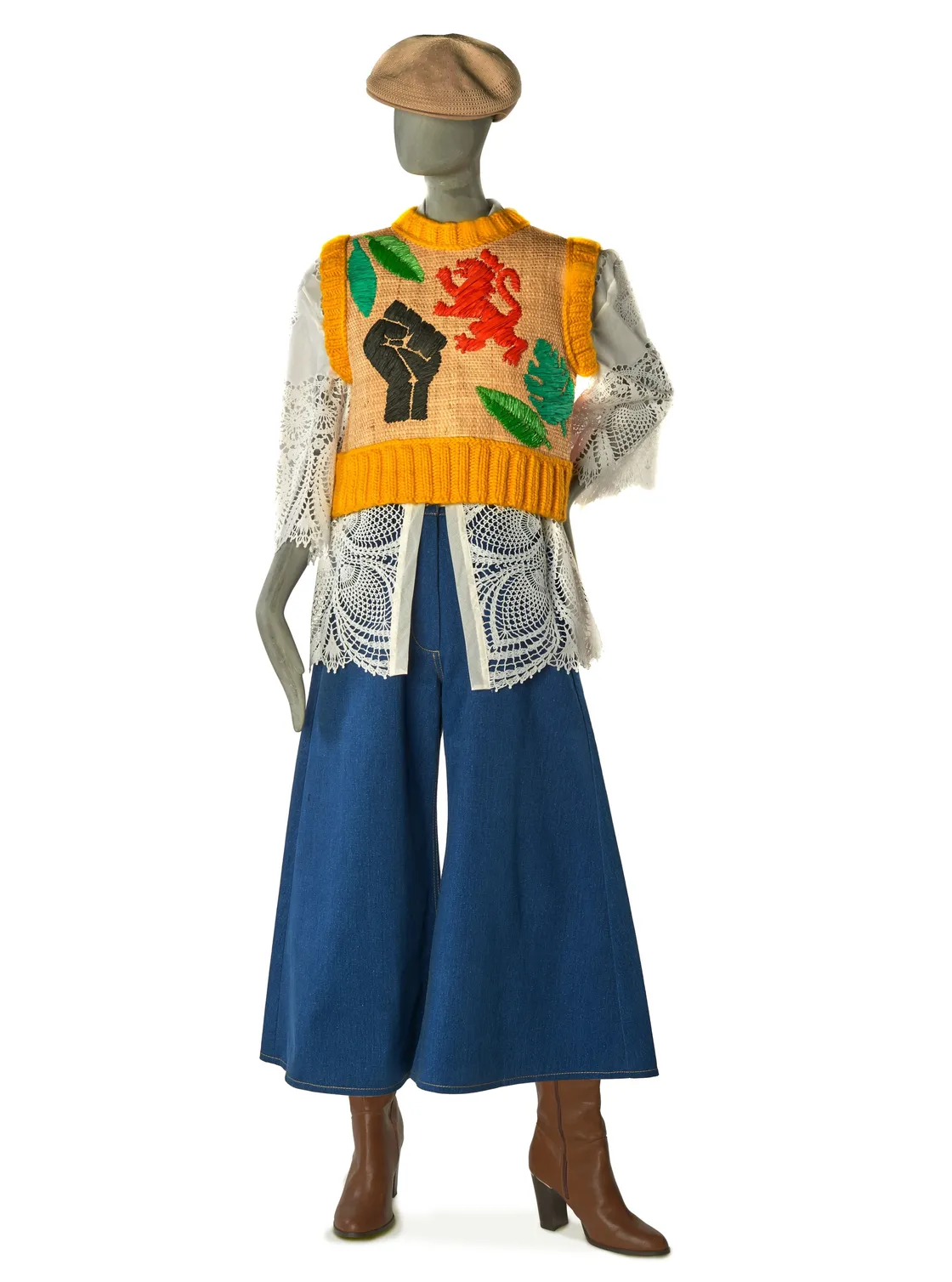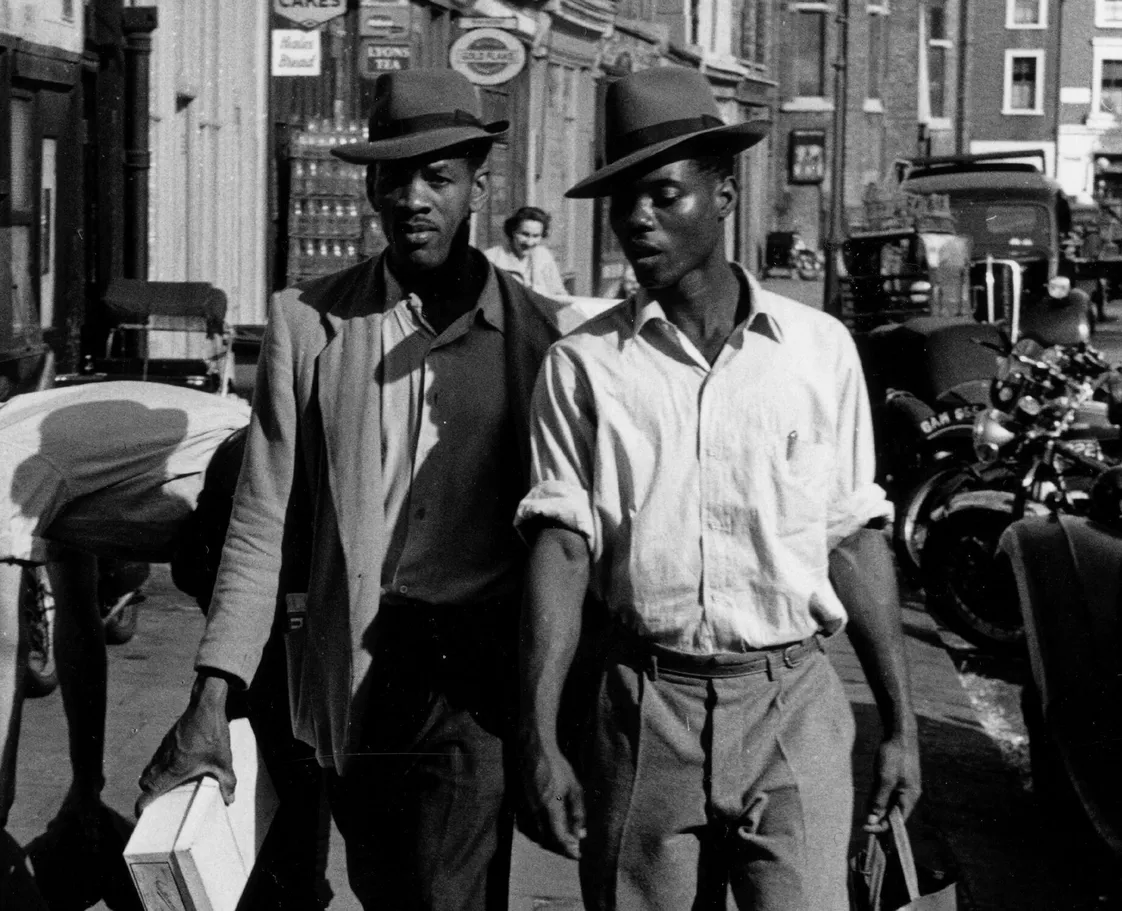21 June 2021 — By Lucie Whitmore, Rianna Norbert-David
Black & British: A fashionable Windrush story
Two fashion ensembles and a group of oral histories from Tihara Smith and her granddad Lazare Sylvestre in the museum’s collection tell a multi-generational story about immigration, life in London and a shared love for fashion.
In 1948 the Empire Windrush arrived at Tilbury Docks filled with hopeful and vibrant people from across the West Indies. This was the well-known beginning of an important time in London’s history, and those passengers helped to rebuild a recovering Britain after the Second World War. Over 60 years later, when the ‘Windrush scandal’ was gaining mainstream news coverage, Tihara Smith had already embarked on the creative journey of telling her family’s story of migrating to the UK from the Caribbean.
Influence of Windrush on British fashion
Graduating from UCA Epsom in 2018 with a final fashion collection that spoke directly to their influence, contributions and legacy, Tihara says her designs “put a positive spin on the Windrush generation to counteract the negative coverage in the news”. At the height of the Black Lives Matter movement following the tragic murder of George Floyd in May 2020, Tihara’s ‘Windrush Collection’ seemed to draw more interest as voices from the Black British community were being amplified.
There was a particular interest in Britain’s complicity with slavery and racism, but also the instrumental roles that those from the Caribbean British colonies (and their descendants) had played in the financial, political and social success of the country. With the world’s eyes opening to the influence of migrant communities, by Windrush Day 2020, Tihara’s collection had garnered even more attention, both for the striking design and the personal story it told.

The full ensemble from Tihara Smith’s Windrush collection. The colours and designs are inspired by her heritage. The shirt is made from a vinyl tablecloth, reminiscent of the crochet or lace tablecloths often used in the West Indian front room.
Lazare’s story: From Saint Lucia to London
Tihara’s collection tells her family story focusing on her granddad Lazare Sylvestre. Lazare was born and grew up in Vieux Fort, Saint Lucia. After a brief stint with the US Air Force, he came to London aged 19 in 1958. He arrived on the SS Montserrat on a Friday evening, and the following Monday morning started his new job at Boots in Piccadilly Circus.
He soon moved on to work at a nearby garage, where he was scouted to become a boxer because of his build. He had a successful amateur boxing career, competing in London and Germany.
Lazare married Holifay Bramwell – originally from Jamaica – in 1976. He recorded a series of oral histories for London Museum with Tihara and his daughter, Lorna, as the interviewers. The conversation between the three generations draws the listener into Lazare’s memories, including his first impressions of London and his dislike for fish and chips, 12-hour dance marathons at his favourite venues, and the highlights of his boxing career.

Lazare at an exhibition fight for Brixton and District Boxing Club in the mid-1960s.
From tailoring to textiles: Windrush’s fashion legacy
It’s not only Lazare’s story that's represented in Tihara’s collection but also the wider Black British experience. Easily recognisable in the ensemble acquired by the museum are statement pieces that were popular among fashion lovers at the time, such as flared denim jeans and brown leather boots.
While developing the collection, Tihara was struck by the Stand firm inna inglan exhibition at Tate Britain, which featured photography of Black communities in London. Encouraged to focus on her family’s immigrant history, she found old family photographs and studied popular clothing items from the period.
“The shirt is made from a vinyl tablecloth, reminiscent of the crochet/lace tablecloths often used in a West Indian front room”
She looked to Neil Kenlock’s photography of Black Panther members in 1970s London for further inspiration. The Black power fist logo and the slogan ‘Black & British’ embroidered onto the raffia vest reflect feelings of marginalisation and resistance of the time, while the red lion symbol links to the pride and experience of being Black and British.
The shirt is made from a vinyl tablecloth bought in Peckham Market, reminiscent of the crochet or lace tablecloths often used in a West Indian front room. This front room, known for elaborate decoration and ornamental objects, was the pride and joy of the Caribbean diaspora. This was a space reserved for special occasions and entertaining guests.
The use of traditional craft material
Tihara was inspired by the traditional crafts of Saint Lucia like the embroidered straw bags and fans. These handicrafts, rooted in the Arawak Amerindian traditions from two millennia ago, continue to influence craftspeople in Choiseul, south of the island.
The baskets and fans are made using grass in the region’s farmland areas. These are handwoven using a special technique. They can also be made using straw raffia and embroidered with a coloured raffia on top. Tihara visited a fabric shop in London that stocked similar raffia material, reminding her of the woven goods of Saint Lucia. This then became one of the main fabrics in her collection.
A fashionable family
Tihara’s interest in fashion and sewing dates back to her school days, but a sense of style runs across generations. Lazare has always been a stylish man, with a particular taste for Italian tailoring. He loved dressing up to go dancing. In an interview he described his outfits: “I had on my colourful West Indian clothes, in a likkle sharp suit and a likkle trilby hat. […] They nicknamed me 'tailorman' because I was so well dressed.”
The suit acquired by the museum was made for Lazare by Winceslas ‘Winston’ Giscombe, a tailor from Kingston, Jamaica. The pair first met at The Silver Buckle, a Camberwell pub. Winston approached Lazare and said he'd like to cut him a suit, as he had a good shape for tailoring.
Lazare remembers: “I laughed at first, not knowing that he was a tailor, but I thought I’d give him a chance. He ended up making me around five or six suits.” Before meeting Winston, Lazare used to buy his suits from “the top tailor shops at the time […] But after Winston started making my suits, I didn’t want to buy from them as they weren’t as good.”
This is the last suit that Winston made for Lazare. He purchased it as “just a casual ting”, but ended up wearing it to be best man at a friend’s wedding, as well as various other special occasions.
Winston, the tailor man
Winston came to England on a ship called the Ormonde in March 1947. He was 28 years old. Though the arrival of the SS Windrush in 1948 is generally cited as the start of post-war Caribbean migration to the UK, the Ormonde docked in Liverpool with over 100 Jamaican people on board, a full 15 months earlier. Many had purchased one-way tickets, risking everything to start a new life in the ‘mother country’. The passenger list shows that Winston was heading to west London but, like Lazare, he settled in the south of the city – living around Peckham and Camberwell.
The passenger lists of the SS Windrush show that over 100 of the Caribbean passengers were artists and craftspeople, including one hatter, 10 shoemakers, 11 dressmakers and 34 tailors.
“There were many Caribbean tailors in Britain who served their local communities, and a smart suit was deemed essential”
Lorna Holder, designer and author
When Lazare first met Winston in the 1960s, he was working from a garden shed at his home in Camberwell. Previously, he’d worked for a tailor in east London and would return to the same area to buy fabric. The East End was home to a vast number of Jewish immigrants, many of whom worked as tailors. It’s possible that Winston’s employers were Jewish too. As designer and author Lorna Holder observed, many Caribbean tailors in Britain served their local communities, and a smart suit was deemed essential, for older men in particular.
While we do not currently know many more specific details of Winston’s career, we hope to add context to his experiences by exploring the lives of other Caribbean tailors who settled in London. The suit he made for Lazare, alongside the oral histories and Tihara’s designs conveys a powerful story of the creativity, skill and culture that came to London with the Windrush. These objects allow us to share that story with future generations of museum visitors.
Rianna Norbert-David is Assistant Curator and Lucie Whitmore is Fashion Curator at London Museum.











